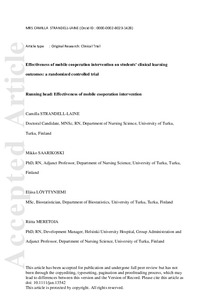Effectiveness of mobile cooperation intervention on students' clinical learning outcomes: A randomized controlled trial
Riitta Meretoja; Helena Leino‐Kilpi; Leena Salminen; Camilla Strandell‐Laine; Eliisa Löyttyniemi; Mikko Saarikoski
https://urn.fi/URN:NBN:fi-fe2021042719080
Tiivistelmä
Aims
The aim of this study was to evaluate the effectiveness of the mobile cooperation intervention in improving the competence and self‐efficacy of students and the quality of the clinical learning environment.
Background
For students, the clinical practicum is challenging as such and moreover the student — teacher cooperation, which supports the clinical learning of the students, has become complicated. Mobile applications have potential but their role in facilitating this cooperation remains unknown.
Design
A parallel‐group randomized controlled trial.
Methods
Data were collected between January–March 2015 in Finland. The nursing students were randomly allocated to an intervention group (N = 52) or control group (N = 50). The intervention group used a mobile application to cooperate with the teacher during the clinical practicum. The control group engaged in standard cooperation. The primary outcome was competence. The secondary outcomes comprised self‐efficacy and the quality of the clinical learning environment. Nurse Competence Scale, Self‐efficacy in Clinical Performance instrument and the Clinical Learning Environment, Supervision and Nurse Teacher scale were used for student self‐assessments. For the main analysis, hierarchical linear mixed models were used with the intention‐to‐treat principle.
Results
Competence and self‐efficacy showed no significant between‐group differences in mean improvements, but significant improvements in both groups were detected over the 5 weeks. Satisfaction with the clinical learning environment showed no significant between‐group differences, however, the role of the nurse teacher subscale, especially regarding cooperation, showed significant group differences.
Conclusion
The mobile cooperation intervention was not significantly effective in improving individual outcomes, but did seem to improve significantly some aspects of the contextual outcomes.
Kokoelmat
- Rinnakkaistallenteet [19204]
